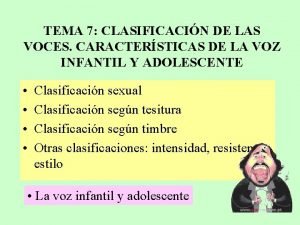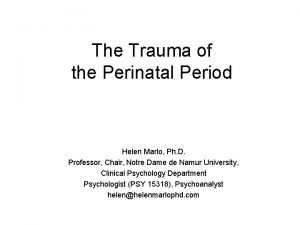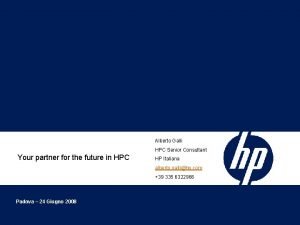Gregg Lueder Marlo Galli JAAPOS Journal of American


















- Slides: 18

Gregg Lueder & Marlo Galli ( JAAPOS ) Journal of American Association for Peadiatric Ophthalmology and strabismus 2008

� Infantile esotropia or "congenital" esotropia is a common type of childhood strabismus. � This esodeviation has onset before 6 months of age and occurs in children who have a low refractive error and typically are neurologically normal. � Donahue, SP. Clinical practice. Pediatric strabismus. N Engl J Med 2007; 356: 1040. � Guthrie, ME, Wright, KW. Congenital esotropia. Ophthalmol Clin North Am 2001; 14: 419

� The esotropia is typically large angle, usually greater than 25 to 30 prism diopters � Children who have infantile esotropia sometimes turn their faces toward the fixing eye, which is preferably positioned in adduction (cross-fixation). � Guthrie, ME, Wright, KW. Congenital esotropia. Ophthalmol Clin North Am 2001; 14: 419

Child with infantile esotropia

� Idiopathic infantile esotropia is associated with a variety of other ocular motility abnormalities that may manifest later in childhood as: � Oblique muscle dysfunctions � Dissociated strabismus complex � Latent nystagmus � Amblyopia, ( which may develop in 17 to 50% of affected children ). • Calcutt, C, Murray, AD. Untreated essential infantile esotropia: factors affecting the development of amblyopia. Eye 1998; 12 ( Pt 2): 167.

� Surgery designed to strengthen or weaken the extraocular muscles is the mainstay of therapy. The procedure most commonly performed is to weaken the medial rectus muscle(s). � Usually it is performed in both eyes. � Successful ocular alignment initially is achieved in the majority of children. • Birch, E, Stager, D, Wright, K, Beck, R. The natural history of infantile esotropia during the first six months of life. Pediatric eye disease investigator group. J AAPOS 1998; 2: 325.

� The primery goal of treating infantile esotropia is to restore binocular vision and the Surgical realignment of the eye is the principal method used to achieve this goal.

� Several studies have demonstrated that restoring alignment prior to 2 years of age results in better outcomes compared with alignment at a later age. � Taylor DM, ME, How early is early surgery in the management of strabismus? . Arch Ophthalmol 1963; 70: 752 -6 � Zak TA, Morion JD, Early surgery for infantile esotropia. Can J Ophthalmol 1982; 17: 213 -8 � Simonsz HJ, Kolling GH, Unnebrink K. Final report of early vs late Infantile strabismus surgery study (ELISSS) a controlled, prospective, multicenter study. Strabismus 2005; 13: 169 -99

� Some strabismus surgeons postpone surgery until the angle of deviation stabilizes. � This approach, however, may result in a delay of treatment that could adversely affect the outcome. .


Gregg Lueder & Marlo Galli (J AAPOS ) Journal of American Association for Peadiatric Ophthalmology and strabismus 2008 • Department of Ophthalmology and visual sciences, Washington University, School of Medicine, St Louis, Missouri, USA

� Some strabismus surgeons wait until the angle of deviation stabilizes prior to operating on patients with infantile esotropia. � This study evaluated whether a preoperative increase in the angle of deviation affected surgical outcomes.

� This was a retrospective comparative case series in which records of patients with infantile esotropia, who had surgery performed before age 2 years and who were followed for at least 2 years postoperatively, were reviewed to identify two groups for comparison: � the first had ≤ 5Δ change in the angle of deviation between the first office visit and time of surgery � the second had a ≥ 10Δ increase in the angle of deviation prior to surgery. “ surgery was performed for the angle present at the time of surgery “.

� Outcomes were considered successful if the patients had microtropias. � All the angle of measurements were performed by a certified orthoptist. � The surgeries were all performed by a single surgeon. � Surgery consisted of bilatral medial rectus recessions with or without botulinuim toxin injection. “ botox injections were used with angle of 65 PD or greater “.

� 15 patients were identified in each group. � The interval between the first office visit and time of surgery was the same in both groups (mean, 2 months). � Outcomes were successful in 11 of 15 (73%) in each group (no significant difference, p = 0. 659).


� There was no difference in outcome between children whose angles of deviation were stable and those whose angles increased prior to surgery. � This indicates that strabismus surgery does not need to be delayed while waiting for the angle of deviation to stabilize. � Surgical correction may therefore be achieved at an earlier age, which may have a beneficial effect on outcome. .

 Marlo carlo
Marlo carlo Talleres marlo
Talleres marlo Helen marlo
Helen marlo Encaje cuadrilateral
Encaje cuadrilateral Las voces del desierto resumen
Las voces del desierto resumen Alberto galli
Alberto galli Calciflorae
Calciflorae Crista galli
Crista galli Lame papyracée ethmoide
Lame papyracée ethmoide Massimo galli
Massimo galli Funeral por el anarquista galli
Funeral por el anarquista galli Ascaridia galli ciclo biologico
Ascaridia galli ciclo biologico Galli giovanna
Galli giovanna Emma galli sapienza
Emma galli sapienza Emma galli sapienza
Emma galli sapienza Troy leon gregg
Troy leon gregg Gregg vs georgia
Gregg vs georgia Annette gregg
Annette gregg трой леон грегг
трой леон грегг

































